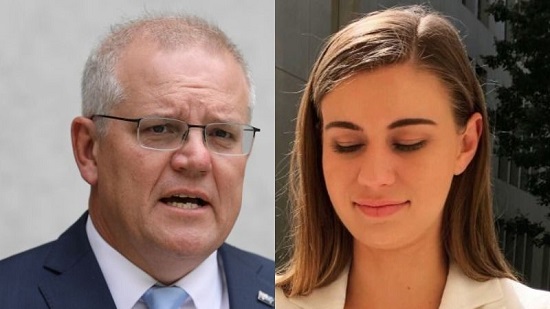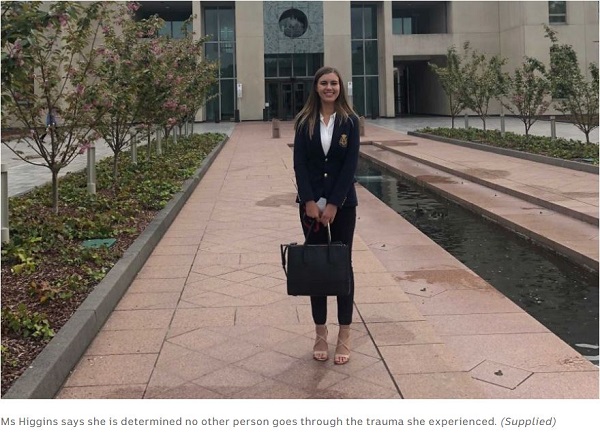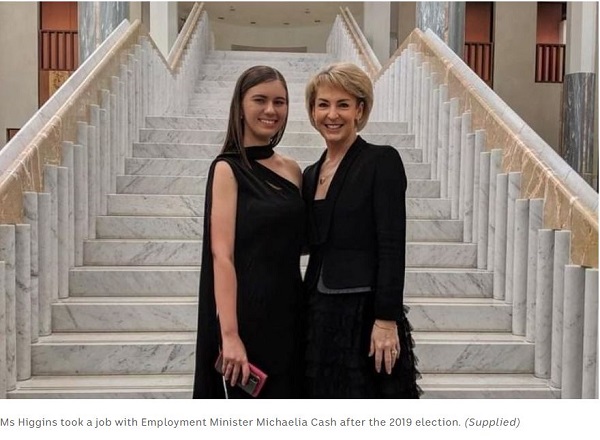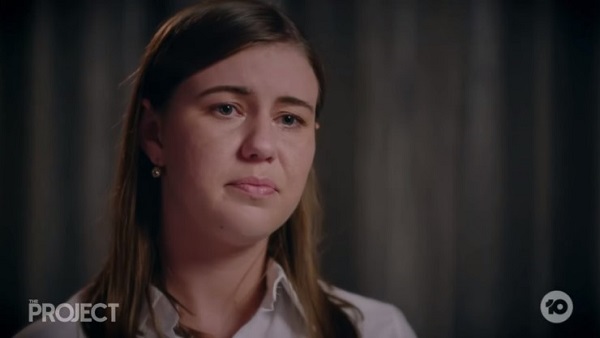
Samantha Maiden’s story about Brittany Higgins’ alleged rape on the couch in Minister Linda Reynolds’ office shortly before the 2019 election has undoubtedly been the story of the week.
Higgins was just 24 years old, was less than a month into her new job, and it was just weeks before PM Scott Morrison called the 2019 election.
There was just one interview between Higgins and Reynolds and a senior staff member, in Reynolds’ office, when:
-
During the meeting, Ms Higgins said Senator Reynolds expressed horror at what had happened to her but also wanted to be clear whether she intended to go to the police or not.
Higgins says she felt physically ill in the room. All the good things were said – she would be supported if she went to the police, and it wouldn’t affect her career, and she was encouraged to talk to the police.
Reynolds never spoke of the incident again, but there was plenty discussion at the staff level.
In a Phillip Coorey AFR article he says that in a version of events she compiled recently to help her recollect what happened she identified 26 people she believes were aware of the event. She would have missed some. For example, she had no idea that a security guard checked her out lying dishevellled on the couch, asked whether she had been raped and offered to call an ambulance.
Contra PM Morrison, she said the Prime Minister’s office provided support to the Minister and her office in assessing the breach of the Statement of Standards for Ministerial Staff.
In Michelle Grattan’s report Grattan on Friday: Scott Morrison dealt poorly with a young woman’s shocking story the role of Lara Brown, Reynolds’ chief of staff was critical:
- Higgins said on Wednesday Reynolds’ then chief of staff, Fiona Brown, who primarily handled things, “continually made me feel as if my ongoing employment would be jeopardised if I proceeded any further with the matter”.
Brown had come from the PM’s office, and returned there after the election. She probably had a good grasp of the realities of the situation. Reynolds was a new minister, only about a month in the job.
In Grattan’s piece View from The Hill: Linda Reynolds feels the lash after Scott Morrison says he was blindsided by rape allegation she says that it is by no means clear that it was Reynolds’ job to inform the PM. Grattan says she was effectively thrown under the bus by Morrison.
There seems little doubt that the PM’s office knew about the incident. Higgins says that the PM’s principal private secretary, Yaron Finkelstein, spoke with her after the ABC’s Four Corners program aired a piece about the workplace culture in Parliament House to check how she was travelling. He seems to have had a memory lapse, although a trail of texts to PM’s office may reveal who knew what.
Many, including former PMs Rudd and Turnbull are inclined to believe that Morrison did in fact know of the incident. My own private theory is to believe him. I think people around him who knew him well would have anticipated that he would do roughly what he has now done – yell at people behind closed doors, show appropriate emotion in public to show he is a man of feeling, smother the issue with a torrent of words, and start a bunch of inquiries – not what was needed with an election coming down the road.
So politics takes precedent over a crime being committed in the office said to be about 25 metres away from the PM’s
To do him credit, I think he genuinely wants the place fixed. For the ABC, James Glenday, Andrew Probyn and Matthew Doran have done an explainer on what happened and who knew what. They don’t mention the role of Lara Brown.
However, here are the four reviews:
The first is being led by Stephanie Foster, a deputy secretary of the Department of the Prime Minister and Cabinet. It will look at the processes in place for dealing with complaints from staff.
The second is being run by Liberal backbencher Celia Hammond. She is examining what can be done to improve working conditions for parliamentary staff in the Coalition.
The third is a cross-party process [led by Senator Simon Birmingham] that will examine what can be done to better support staff in Canberra.
The fourth is the internal inquiry led by Phil Gaetjens. He is aiming to find out what and when staff in the Prime Minister’s Office knew about Ms Higgins’ complaint, potentially going so far as to look at phone records.
Bernard Keane and Georgia Wilkins at Crikey (pay-walled) in Cover-up by review? Morrison’s four inquiries steer clear of how Brittany Higgins was mistreated point out that none of the inquiries are independent and “none have a hope in hell of getting to the bottom of how a young woman’s rape was so shockingly mishandled.” After ‘sports rort’ to ask Phil Gaetjens who is head of Prime Minister and Cabinet to investigate anything is laughable.
They say:
-
Only an external, independent inquiry — with powers to access parliamentary records and communications between staffers and politicians, and question everyone from the PM down — can properly examine how the government so badly mishandled the rape of a young woman in its own ministerial offices.
Judith Ireland (Inside Story) in a piece Late nights, high stress and plenty of booze gives a lively description of what working in the Canberra bubble involves. The basic condition is job insecurity, staff can be sacked at any time if the MP or senator loses “trust or confidence” in them. Then:
- It’s also a job that involves late nights, high stress and plenty of booze. While this is the case in many industries, parliament is a bit different because so many people fly into Canberra for sitting weeks, and fly out again straight after. If not a bubble, it certainly leads to a “what happens on tour, stays on tour” atmosphere for those who participate enthusiastically in the many functions, dinners and drinks that crowd sitting-week evenings.
Former Liberal MP Fiona Scott also points to a “persistent upstairs/downstairs class system” in parliament, which involves everyone who works in the building. “This creates a power imbalance between MPs and all employees at Parliament House,” she told me this week. “And that’s just not in line with wider Australian workplaces.”
Australia may see itself as egalitarian, but inside parliament, MPs are treated as somewhere between gods and celebrities — with separate entrances, separate security processes and separate dining areas. They are chauffeured around in Comcars and brought glasses of water by attendants, and can have lifts especially vacated for them. They are called not by their names but by titles like Mr Speaker, Minister and Senator. Even colloquially, they are known as “the boss.” This special status can also trickle down to their senior staff.
Academics Natalie Galea and Louise Chappell who have just written a paper on Male dominated workplaces and the power of masculine privilege: a comparison of the Australian Political and Construction sectors say To fix the culture in Canberra, we need to take a sledgehammer to male privilege.
They say we need structural change and point to some overseas attempts:
The first step would be the introduction of an independent reporting system for all parliamentary members and staff – one that protects the anonymity of the person reporting a complaint and is enforceable with sanctions.
Tory Shepherd (Crikey again) in I call bullshit. Without tackling male privilege, ScoMo isn’t serious about change says:
- Crisis comms 101: show empathy, deflect, commit to action. Tick, tick, tick.
That commitment to “make sure that this workplace is as safe as possible” is superficially noble, but fundamentally another tick-a-box exercise. It’s bullshit.
I think she’s saying that the best we might look forward to is parliament being as bad as other workplaces, which is pretty bad.
Shepherd’s piece Did Morrison really drag out the tired daggy-dad routine after rape allegations were aired? is also worth a read. It begins:
- On my first night out on the tiles in Canberra as The ’Tiser’s political editor, someone grabbed my arse. Fully and firmly.
It was at the Holy Grail that he had a real crack at it. I whirled around to see three men gurning at me, one of them a senator, the others political operatives. I didn’t know which one was guilty, but they were all amused.
Which show’s how pervasive the problem is.
Now we have a fourth woman coming forward, this one a case of groping. It’s looking like a serial criminal rapist, operating with intent.
This week Penny Wong has “lashed” the government’s response to Brittany Higgins.
- Labor, the Greens and One Nation have accused the government of setting up whitewash inquiries in response to the allegations.
Senator Birmingham has been tasked to consult widely, including with other parties, to establish the terms of reference for an independent review of work culture around Parliament. Larissa Waters and others are calling for Sex Discrimination Commissioner, Kate Jenkins, to lead the review. On 5 March last year Jenkins launched launched Respect@Work, the Australian Human Rights Commission’s report of the National Inquiry into Sexual Harassment in Australian Workplaces 2020:
-
Respect@Work brings together evidence gathered from Everyone’s Business, the Commission’s fourth national survey on sexual harassment in Australian workplaces (Everyone’s business), which surveyed 10,000 Australians, in addition to 60 public consultations with more than 600 people across Australia, 460 submissions, and global research and economic modelling on the cost of sexual harassment.
Through a package of 55 recommendations, Respect@Work proposes a new approach for government, employers and the community to better prevent and respond to sexual harassment in the workplace, and position Australia as a world leader in addressing workplace sexual harassment.
In her Commissioner’s Foreword to the 932-page report she writes:
-
As the 2018 National Survey revealed, almost two in five women (39%) and just over one in four men (26%) have experienced sexual harassment in the workplace in the past five years. Aboriginal and Torres Strait Islander people were more likely to have experienced workplace sexual harassment than people who are non-Indigenous (53% and 32% respectively).[3]
Sexual harassment is not a women’s issue: it is a societal issue, which every Australian, and every Australian workplace, can contribute to addressing.
Workplace sexual harassment is not inevitable. It is not acceptable. It is preventable.
She says:
- The current legal and regulatory system is simply no longer fit for purpose. In this report, I have recommended a new model that improves the coordination, consistency and clarity between the anti-discrimination, employment and work health and safety legislative schemes.
The new model is evidence-based, victim-focused and framed through a gender and intersectional lens. It is also based on existing legal frameworks to avoid duplication, ambiguity and undue burden on employers. Importantly, it recognises the complementary and mutually reinforcing nature of the three schemes, while also recognising their distinctive features.
(Emphasis added)This AFR article on the Respect@Work report said it recommends the focus should be preventative rather than reactive, calling for engagement rather than an adversarial approach. However, the report also recommended new powers to investigate workplaces over sexual harassment and new orders to stop employees sexually harassing their co-workers.
Prof Catherine Lumby talked to Jonathon Green on ABC RN Drive about the work she had done with the National Rugby League over recent years. You have to give priority to fixing the culture, and keep working at it.
Amber Schulz at Crikey says that only 13% of women experiencing sexual assault go to the police. Then around 30% of cases reported to the police led to an arrest, summons, formal caution or other legal action.
Schulz, speaking to the likes of Andrew Bolt, Dennis Shanahan, Peter Hartcher, as well as to PM Morrison, says “Guys, it’s time to shut up.”
So I will too, but with the thought that this goes beyond workplace culture. It’s about what we are, how we relate and behave towards each other.
Brittany Higgins went off to work with a spring in her step:

She was brave when she went to work for Michaelia Cash after the 2019 election:

She is brave now, seen here on Channel 10’s The Project:

If Morrison delivers we will all have much to thank her for. We can then thank him for doing his job.

Paul Bongiorno says today that the Morrison government is a shambles by its own admission.
Given that there was AFP involvement it is inconceivable that Peter Dutton didn’t know.
The comment is also repeated in a Tweet that the Government has been quietly spreading stories about Brittany Higgins current partner.
See also Samantha Maiden – Brittany Higgins’ partner David Sharaz speaks out.
Moira Rayner, barrister, workplace and human rights lawyer, and Victoria’s first Equal Opportunity Commissioner was quite scathing today talking to Linda Mottram on ABC RN in Abuse scandal shows Parliament needs investigation into “non-functioning” workplace system.
Put the cleaners through the joint, she says. Install good systems and some rules and teach politicians how to behave.
Any way, worth a listen.
Louise Milligan has posted a story Scott Morrison, senators and AFP told of historical rape allegation against Cabinet Minister.
The alleged rape occurred in 1988 in Sydney, before the said cabinet minister embarked on a political career.
NSW Police provided a statement to the ABC about the case:
“In February [2020], NSW Police received a report of alleged historic sexual abuse. Inquiries were commenced by officers from the Child Abuse and Sex Crimes Squad under Strike Force Wyndarra.”
Detectives from Strike Force Wyndarra were due to travel to Adelaide to take the woman’s formal statement in March 2020 but their trip was postponed after the COVID-19 outbreak erupted and state borders were closed.
Friends of the woman, who had years earlier been diagnosed with bipolar disorder, say her mental health deteriorated in the weeks before she took her life. She had made previous suicide attempts.
The NSW Police statement said: “On Wednesday 24 June 2020, the body of a 49-year-old woman was located at a home at Adelaide by South Australia Police (SA Pol).”
The day before she took her life, the woman informed NSW Police that she no longer wished to proceed with the investigation.
Legal action is now no longer possible because the allegation cannot be tested.
The woman had prepared a detailed statement for her solicitor at the end of 2019.
“This is my story, plain and simple. It’s not pretty, but it is mine,” she wrote in the statement.
“And I stand by it, every single word and image in this document is true.”
…
“All I really want, in the end, is for this to have been reported to the NSW Police Force and to know that a copy of this document, and a transcript of any interview they might do with me, is in their archives…
“If this story does become public knowledge, I hope that it will encourage other women to come forward.
“Not for me, but for themselves… I also hope that other people who have endured similar traumas, should these facts become public knowledge, will feel less alone.”
Claims of ‘cover up’ as PM’s department pauses review into Brittany Higgins
For 13 days Morrison has been deflecting questions about the Gaetjens inquiry into what Morrison’s office knew, even suggesting “ask Gaetjens” while knowing he had asked Gaetjens to pause the inquiry so as not to interfere with whatever the AFP had been doing. Then contrary to what was claimed, the AFP advise they had not sought such a pause.
Typical of the evasion and lack of transparency from the Morrison government.